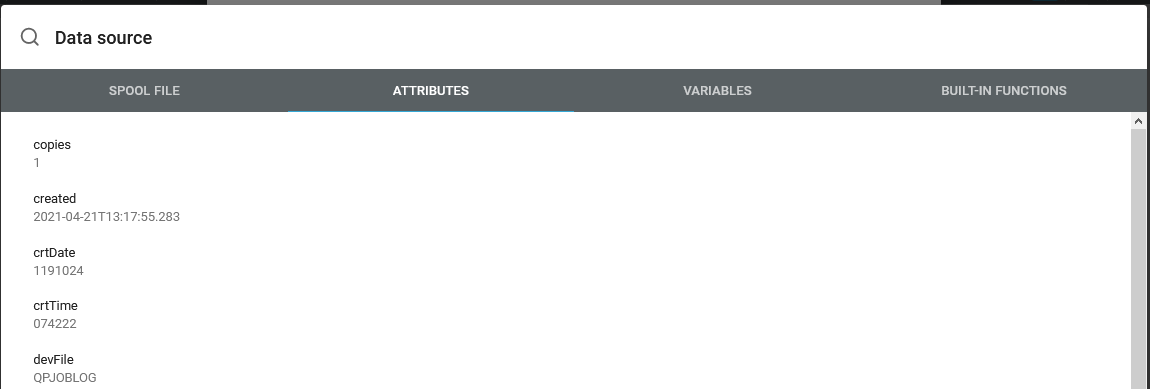You can use a lot of spooled file attributes, when you create a template in the designer.
You can e.g. use spooled file attributes in the designer in multiple way: Inside conditions or e.g. simply include them in a text element.
You can refer to spooled file attributes in two ways:
1.Refer to predefined workflow variables, that contains the spooled file attributes.
2.Refer to the attributes directly in the designer.
The second option is recommended.
Refer to predefined workflow variables for the attributes
One way to use spooled file attributes in the designer is to use the predefined workflow variables, that contains the spooled file attributes. There are two downsides with this:
1.You cannot see the variable names directly in the designer, but you need to copy the variable names from either a workflow, that is setup to monitor an output queue on the IBM i platform, or you need to copy the variable name from this list.
2.You cannot directly see the right value of any spooled file attribute in the designer. Instead you need to define the same variable as a workflow variable in the top of your template and here manually set a value, that represents the setup, that you want to use in the designer session.
The advantage is, that you can use the same variables, that you can use the workflow.
Refer to the attributes directly in the designer
If you have loaded a spooled file as the input document in the designer, then you have directly access to the attributes of the spooled file, if you insert an XPath function in any of the design elements.
You can e.g. insert an XPath expression in a Text element, if you click the Expression option on the top and then the magnifying glass on the left:

Now you have an extra tab in the top (compared to non-spooled files), that is called Attributes:

Here you can simply click the attribute, that you want to refer to. If you e.g. select the User data (USRDTA) field, then this will be inserted:
//@userData
The complete list of the spooled file attributes is included below (in alphanumeric order):
//@copies |
The copies attribute of the input spooled file. The spooled file will be printed this number of times. |
//@created |
Timestamp of when the spooled file was created. |
//@crtDate |
The date when the spooled file was created |
//@devFile |
The printer file (device file), that was used when the spooled file was created. |
//@devLib |
The library of the printer file (device file), that was used when the spooled file was created. |
//@endPage |
The last page to be printed - as specified via PAGERANGE. |
//@formtype |
The form type (FORMTYPE) of the input spooled file. This is very often *STD. |
//@jobName |
The name of the job, that created the spooled file. |
//@jobNbr |
The job number of the job, that created the spooled file. |
//@outq |
The output queue in which the spooled file is placed. |
//@outqLib |
The library of the output queue in which the spooled file is placed. |
//@pageLength |
The maximum number of spooled file lines per page. |
//@pageWidth |
The maximum number of spooled file positions on a spooled line. |
//@pgm |
The program, that created the spooled file. |
//@pgmLib |
The library of the program, that created the spooled file. |
//@splf |
The spooled file name. |
//@splfNbr |
The spooled file number. |
//@startPage |
The first page to be printed - as specified via PAGERANGE. |
//@system |
The system name of the IBM i, where the spooled file was created. |
//@totalPages |
The total number of pages in the spooled file. |
//@user |
The user, that created the spooled file. |
//@userData |
The user data field (USRDTA) of the spooled file. (10 characters long) |
//@usrDefData |
The user defined data field (USRDFNDTA) of the spooled file. (255 characters long) |